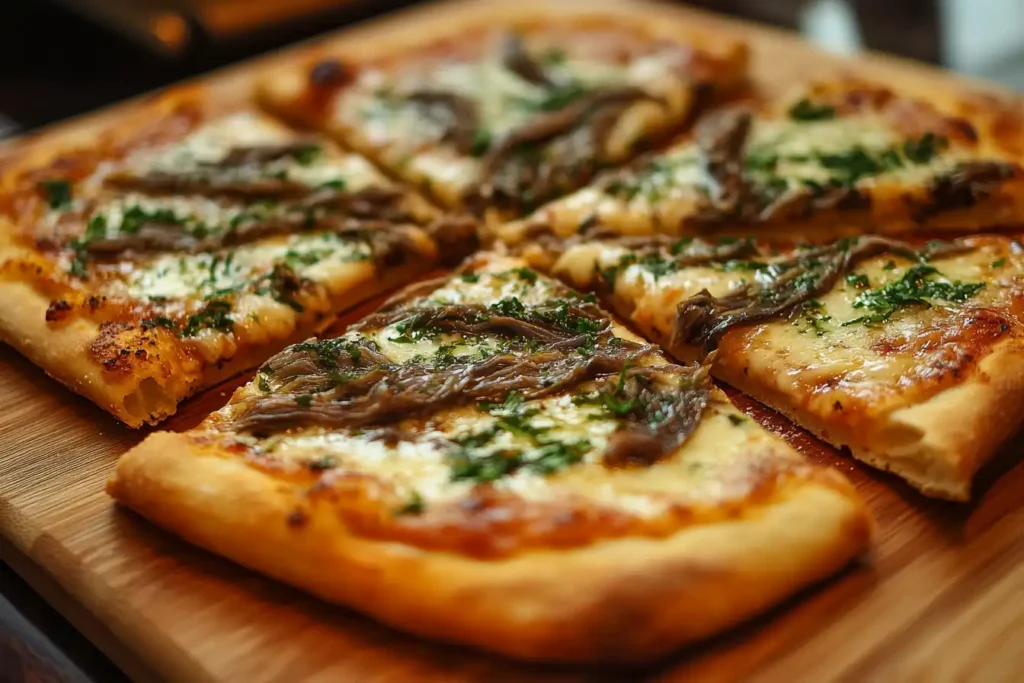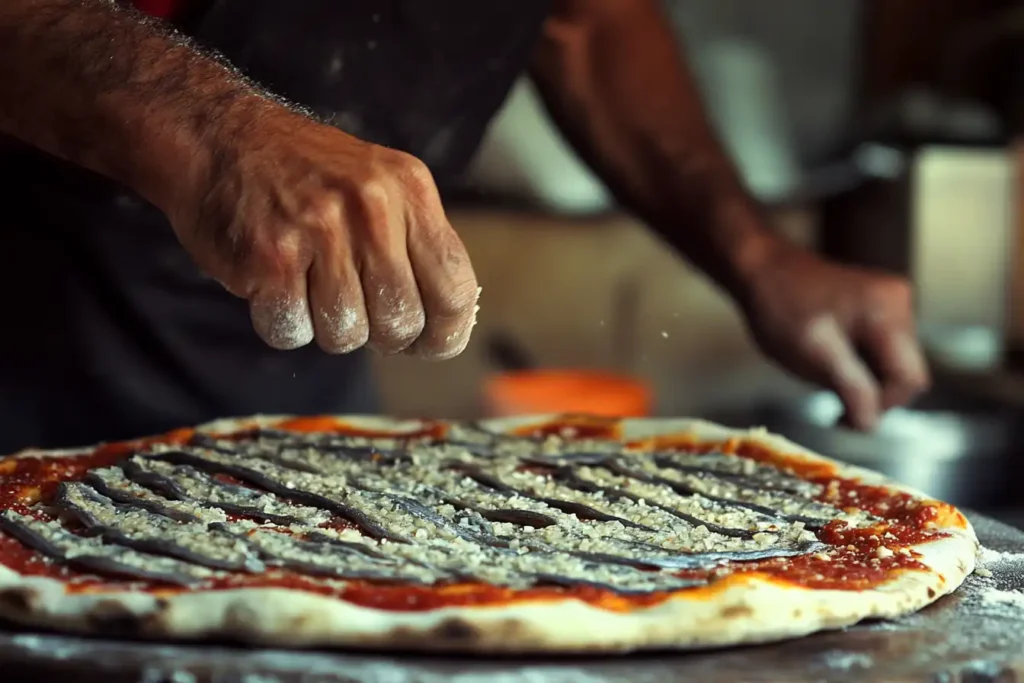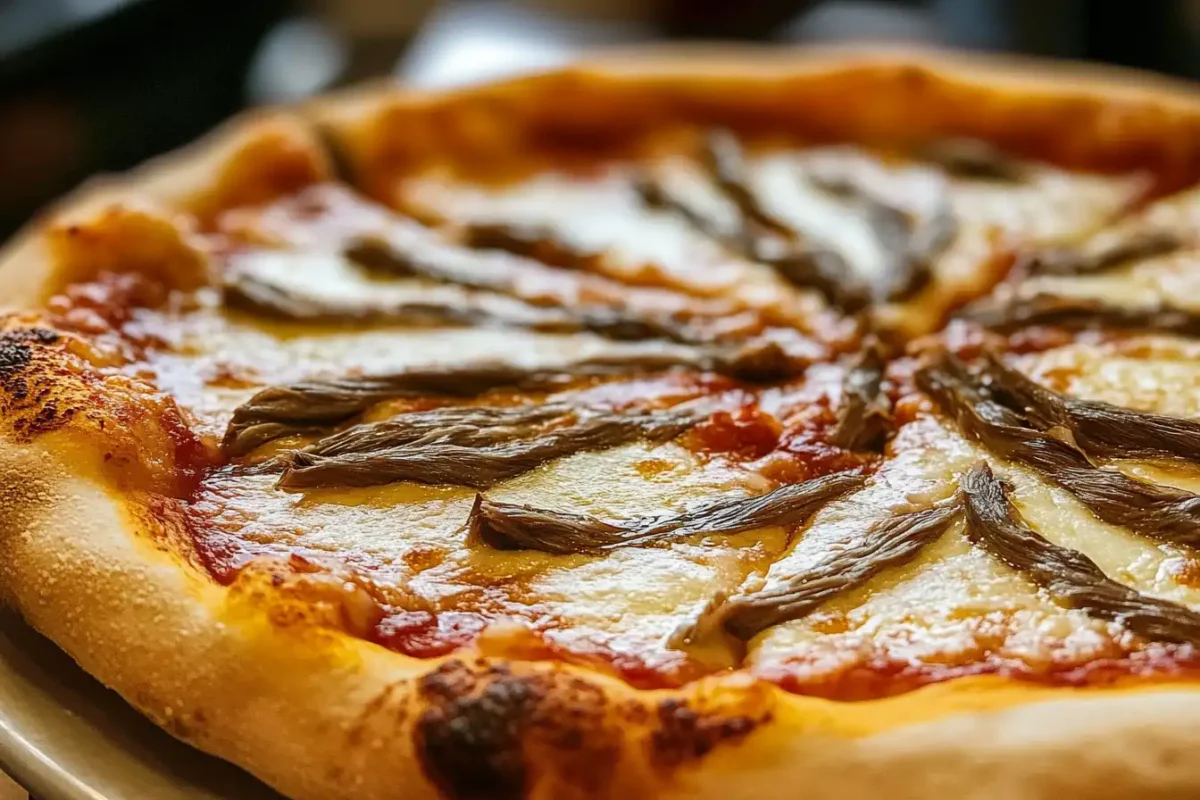Learn how anchovies elevate pizza flavor, their origins, best toppings, and cooking tips for a savory, unforgettable slice.
Anchovies on pizza represent one of the most classic, yet often misunderstood, culinary combinations. Although some diners shy away from these salty fillets, many pizza enthusiasts consider them essential for adding depth, umami, and complexity. For those curious, learn more about whether “Pizza with Anchovies is Healthy” and its nutritional benefits. Anchovies on pizza have been part of traditional Italian dishes for centuries, dating back to the earliest forms of what we now know as pizza. This savory topping, when chosen and prepared well, can transform a simple pie into a gourmet experience that honors time-honored traditions and vibrant Mediterranean flavors.
Anchovies on pizza also connect us to a long line of culinary heritage. These tiny fish were once prized ingredients in ancient coastal towns. Today, chefs and home cooks rediscover them through fresh,anchovies are an important species in marine ecosystems, used widely in various cuisines. Meanwhile, especially when balanced with bright, acidic ingredients. Considering their complexity and storied past, it is no surprise that these flavorful fillets remain a coveted topping in pizzerias worldwide.
In the upcoming section, we will explore the long and storied journey of anchovies on pizza, tracing their origins in ancient times and understanding how they evolved into the iconic topping we know today.
History and Origin of Anchovies on Pizza
In the subsequent chapter, it is crucial to understand that anchovies were not a modern
Culinary trend. They have existed as preserved fish for thousands of years. Anchovies on pizza owe their existence to a long-standing Mediterranean tradition of salting and curing fish to improve their flavor. Ancient Romans, for example, famously made garum, a fermented fish sauce. Although anchovies at that time were not specifically used on pizza, their role in Italian cooking was significant.
In the next stage, when the first pizza-like flatbreads appeared in Naples, salted and pickled fish were often used as garnishes. The strong, savory taste of salted fish paired perfectly with the simple tomato base that defined early pizza margherita and marinara styles. Over time, anchovies became strongly associated with traditional Neapolitan pizza recipes, representing authenticity and a connection to gastronomic traditions.
In the following section, these traditions spread and evolved. As pizza expanded to other countries, some regions fully embraced anchovies, while others avoided them. However, Italy’s coastal heritage ensured that preserved fish remained a constant influence. From the narrow streets of Naples to modern high-end pizzerias in the United States, anchovies on pizza have endured.
Moving to the next part, let’s explore the anchovy itself: how to pick, prepare, and enjoy this small fish that can elevate pizza flavor to surprising levels.
The Anchovy Itself: Flavor, Types, and Selection
Anchovies on pizza have a strong, savory taste. Next, imagine biting into a slice and getting a burst of rich flavor. Anchovies are different from other toppings because they add depth instead of just saltiness. They mix perfectly with tomato sauce, cheese, and other ingredients.
In the next section, there are different types of anchovies to choose from. Oil-packed anchovies are the most common and have a mild, smooth flavor. Salt-packed anchovies are stronger and need rinsing to tone down their boldness. Fresh anchovies, which are less common on pizza, are gentler in taste but harder to find and prepare. Choosing anchovies means looking for good brands, sustainable fishing, and proper curing methods.
Now moving on, we’ll look at the health benefits of these small fish and why they can be a healthy addition to your pizza nights
Health Benefits and Nutritional Profile
Anchovies on pizza are not only about flavor; they also offer nutritional perks. Advancing to the next topic, anchovies contain lean protein, healthy omega-3 fatty acids, and an array of essential vitamins and minerals.
In the next division, even though anchovies are high in sodium, moderate use can fit into a healthy lifestyle. Consider balancing them with potassium-rich vegetables or lower-sodium cheeses.
On to the following discussion, you can compare anchovies to other popular seafood toppings like shrimp or smoked salmon. Anchovies usually have a more intense flavor, so a little goes a long way.
Traditional Pizza Styles Featuring Anchovies
In the next subsection, start with Pizza Napoletana, a traditional style from Naples. The genuine pizza marinara sometimes includes anchovies, adding depth to a simple mix of tomatoes, garlic, and oregano. Similarly, Pizza Napoli, often topped with anchovies and capers, shows the harmony between salty and savory flavors.
Moving on to the next topic, in different Italian regions, you will find varieties like pizzas layered with oil-preserved anchovies, black olives, and onions. These reflect local preferences and ingredients while keeping the anchovy’s central role.
In the following chapter, French pissaladière, a flatbread topped with caramelized onions, olives, and anchovies, shows how anchovies are used outside Italy. Other European cultures have their own flatbreads with these small fish, showing their wide acceptance.
In the next chapter, famous pizzerias in Rome, Naples, and other places still feature anchovy-topped pies as signature dishes. Their chefs know that these fillets add a special flavor that connects customers to Italy’s food traditions.
Continuing in the following part, we now examine the art of pairing anchovies with other toppings to create a well-rounded, delectable pizza experience.
Pairing Anchovies with Other Pizza Toppings
Anchovies on pizza require balance. In the next step, try classic pairings like olives and capers, which reflect anchovies’ salty flavor. This creates a harmonious taste. Garlic and chili flakes add spice and richness, while tomatoes bring tanginess. Together, these ingredients make a complete flavor experience.
In the following part, vegetables like bell peppers, artichokes, and arugula can tone down the strong flavors, adding freshness and crunch. Herbs like basil, oregano, or thyme also enhance the taste. Cheese is important: mozzarella’s creaminess softens the anchovy’s intensity, while pecorino’s sharpness matches well with the salty notes.
In the next section, explore sauces. A simple tomato sauce works great, but a white sauce or even caramelized onions can offer a different match for anchovies. Stay flexible. Sometimes, less is more. Using just a few anchovies can create better results than covering the entire pizza.

A savory pizza with anchovies, cheese, and parsley, served in slices.
Techniques for Preparing Anchovies on Pizza
Proper preparation makes anchovies on pizza taste balanced and enjoyable. Moving to the next point, if anchovies seem too salty, rinse them gently under cold water and pat them dry. This step reduces saltiness and keeps their texture intact.
In the following section, when topping your pizza, arrange anchovies carefully. Spreading them evenly prevents any slice from being too intense. Keep in mind that anchovies become stronger in flavor as they bake. If you’re not used to their taste, use them sparingly.
Next, oven temperature and baking time affect how anchovies release their oils. High heat brings out stronger flavors, while lower heat can make them milder. Experiment with different baking methods to find the flavor you like best.
Finally, think about using anchovy paste as an option. Mixing a small amount into the sauce can add a subtle savory taste without the stronger presence of whole anchovies.
In the next subsection, we will provide a detailed, step-by-step recipe for making your own anchovy pizza at home, ensuring you master the art of this often-overlooked topping.
Crafting Homemade Anchovy Pizza
Creating homemade anchovies on pizza is straightforward. Moving forward to the next topic, begin with a quality dough. For the dough:
- 3 1/2 cups “00” flour (or all-purpose flour)
- 1 1/3 cups lukewarm water
- 2 tsp active dry yeast
- 2 tsp salt
- 1 tbsp olive oil
Transitioning into the following chapter, dissolve yeast in water, add flour, salt, and oil, and knead until smooth. Let it rise until doubled. Roll or stretch the dough into a circle. For the sauce, use crushed San Marzano tomatoes, a pinch of salt, and a drizzle of olive oil.
Proceeding to the next chapter, top with a few anchovy fillets, thin slices of garlic, and a handful of mozzarella cheese. Add optional olives or capers for complexity. Bake in a preheated oven at 500°F until the crust is crisp and the cheese is bubbling.
In the next phase, discover modern twists on traditional anchovy pizza, inspiring you to push beyond classic combinations and personalize your pizza-making adventures.
Modern Twists and Creative Anchovy Pizza Variations
Today, anchovies on pizza can be given a fresh twist. In the next part, try combining anchovies with roasted red peppers or caramelized onions. The sweetness balances the salty flavor of the fillets.
In the following section, think about mixing in creative flavors. For example, add a drizzle of honey or use figs for a sweet-and-salty mix. Cheeses like burrata or goat cheese can elevate the dish, making it feel more refined and perfect for gourmet menus.
In the next step, consider health-focused changes. Use whole-grain crusts, add extra vegetables like spinach or mushrooms, and reduce the amount of cheese. These options suit different diets while keeping the anchovies’ special taste.
Moving forward, don’t hesitate to experiment. Anchovies can act as a flavor booster. Use them lightly to bring out the taste of other ingredients, like artichokes or sundried tomatoes, creating a rich and unique pizza experience.
In the next division, let’s address the cultural perceptions and controversies surrounding anchovies, which remain one of the most debated pizza toppings in the U.S.
Cultural Perception and Controversy
Anchovies on pizza often lead to debate. Moving to the next point, some people love them, saying their strong flavor is unique. Others dislike them because of what they see as a “fishy” smell or strong saltiness.
In the next section, problems often happen due to poor preparation. If anchovies aren’t rinsed well or paired with suitable toppings, they can dominate the pizza. However, high-quality anchovies, used thoughtfully, can bring a rich and pleasant flavor instead of an unpleasant odor.
Next, some pizza places in the U.S. have stopped offering anchovies due to low demand. Others keep them as a special request. Regional differences play a role: coastal areas or cities with strong food traditions are more likely to include anchovies on their menus.
Looking ahead, the anchovy debate is really about personal taste. While not everyone will enjoy their strong flavor, those who learn how to use them correctly often become big fans.
Lastly, let’s talk about how to choose anchovies in a way that protects the environment, so future generations can enjoy them without harming the planet.

A chef adding cheese to a pizza with anchovies and tomato sauce.
Sourcing Anchovies and Supporting Sustainable Practices
Sustainability is important when choosing anchovies for pizza. In the next step, look for brands that follow responsible fishing rules. This helps protect anchovy populations and marine life. Many companies share their sustainable practices on the packaging.
Next, consider asking your local fishmonger or specialty store about their sourcing. If shopping online, choose vendors who clearly explain where their products come from. Doing this helps protect biodiversity.
In the following step, remember that your choices affect the industry. Choosing sustainable products encourages more producers to follow ethical methods.
Lastly, protecting marine resources ensures that anchovies will be available for future generations to enjoy this classic pizza topping.
In the ensuing segment, let’s address common questions that many readers have, helping clear up doubts and guiding you to a better understanding of anchovies on pizza.
Frequently Asked Questions (FAQ)
What are anchovies on a pizza?
Anchovies on pizza are small, salty fish added as a topping. They bring a strong, savory flavor that pairs well with ingredients like tomatoes, olives, and garlic. Their unique taste may take some getting used to, but when added carefully, they can improve the overall flavor of the pizza..
Do Italians put anchovy on pizza?
Italians have a long history of putting salted fish on pizza. Classic Neapolitan pizzas, like Pizza Marinara or Pizza Napoli, often include anchovies. Italians see anchovies as a genuine and important part of their pizza tradition, showing the influence of Mediterranean cooking over the centuries.
Why don’t pizza places have anchovies?
Many pizza places in the U.S. might not have salted fish as a topping because not many people ask for them. Some customers don’t know what they taste like. Also, salted fish need to be stored and handled carefully to stay fresh. Because of this, some restaurants decide not to keep them. However, many pizza places still let customers request salted fish as a special topping.
Why don’t pizza places have anchovies?
Many pizza places in the U.S. might not have salted fish as a topping because not many people ask for them. Some customers don’t know what they taste like. Also, salted fish need to be stored and handled carefully to stay fresh. Because of this, some restaurants decide not to keep them. However, many pizza places still let customers request salted fish as a special topping.
Conclusion
Anchovies on pizza connect old gastronomic traditions with modern creativity. They represent the flavors of coastal Italy passed down through generations. For a deeper dive into their current appeal, explore our “How Popular Are Anchovies on Pizza? Ultimate Guide.” Though not everyone enjoys them, these salty, savory fish can turn a simple pizza into a gourmet meal. By selecting good-quality anchovies, pairing them with the right garnishes, and preparing them well, you can unlock flavors that few other components can match.

